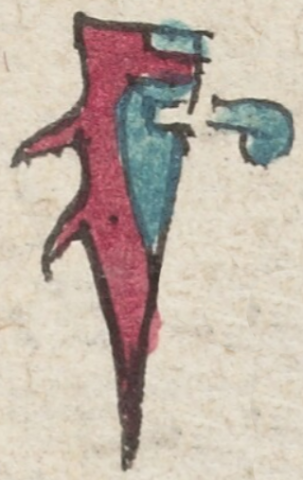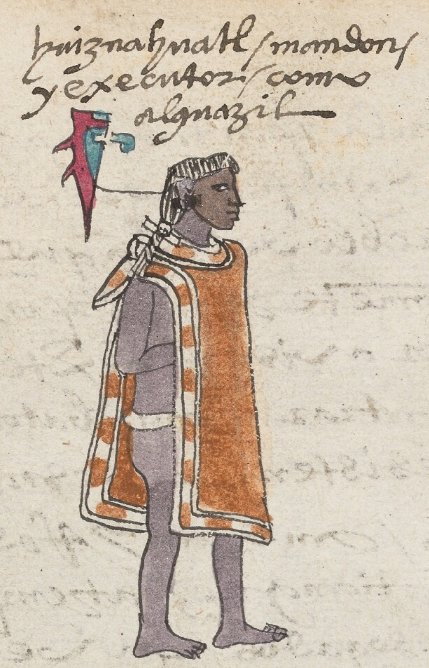Huitznahuatl (Mdz66r)
This compound glyph for the title or occupation of Huitznahuatl (as explained in the contextualizing image, something like mandón or alguacil) includes a thorn (huitztli) and, coming from a simplified open mouth, a curling speech (nahuatl) scroll. The thorn is vertical, with the point downward. It has two additional thorns on its left side. It is shown in profile, facing to the right. There is a red horizontal line just below the top (wider end) of the thorn. The right side (with the mouth) is turquoise, and the left side (with the sharp points) is red.
Stephanie Wood
The thorn and the speech scroll appear to be phonetic indicators, not meant literally. Given that thorns were used in self-sacrificial acts, the red color likely refers to blood. The iconography of the thorn is fairly standard in the Codex Mendoza. However, one group of thorns ("puas de maguey") are shown as green and horizontal elsewhere in the Codex Mendoza.
John Bierhorst (A Nahuatl-English Dictionary and Concordance to the Cantares Mexicanos, 1985, 143) says that Huitznahuatl was a "name or epithet of a god to whom slaves were sacrificed in Mexico." Other sources report that one of the ethnic groups that migrated from the Seven Caves came from a place called Huitznahuac, and there was a temple with this association in Mexico Tenochtitlan. Finally, Huitznahuatl was a high title, and it had an association with the South. The name was not inaccessible for tribute-paying men of humble means, such as found in the census of modern-day Morelos and in the Matrícula de Huexotzinco (modern-day Puebla). See the Online Nahuatl Dictionary for more information about Huitznahuac and Huitznahuatl.
Stephanie Wood
huitznahuatl / mandon /
y executor / como
alguazil
huitznahuatl, mandón y ejecutor, como alguacil
Stephanie Wood
c. 1541, by 1553 at the latest
Stephanie Wood
thorns, espinas, language, lenguaje, hablar, palabras, volutas

huitz(tli), thorn, https://nahuatl.wired-humanities.org/content/huitztli
nahua(tl), speech, language, https://nahuatl.wired-humanities.org/content/nahuatl
(un título, o un oficio)
Stephanie Wood
Codex Mendoza, folio 66 recto, https://digital.bodleian.ox.ac.uk/objects/2fea788e-2aa2-4f08-b6d9-648c00..., image 142 of 188.
Original manuscript is held by the Bodleian Libraries, University of Oxford, MS. Arch. Selden. A. 1; used here with the UK Creative Commons, “Attribution-NonCommercial-ShareAlike 3.0 License” (CC-BY-NC-SA 3.0)








